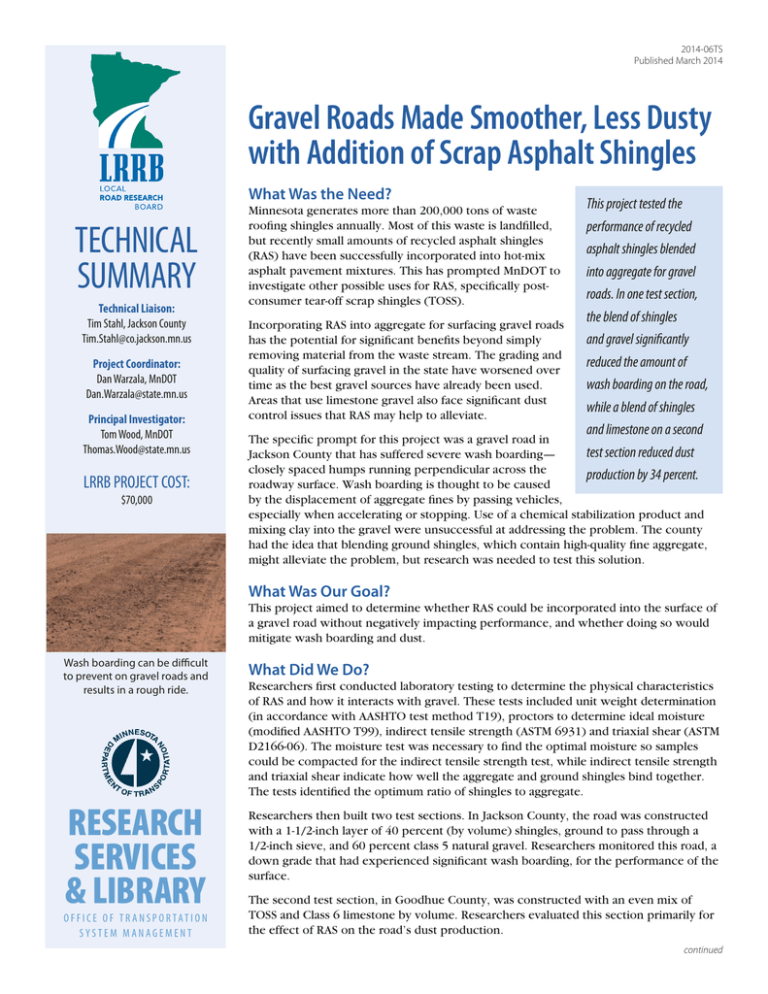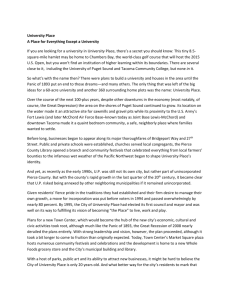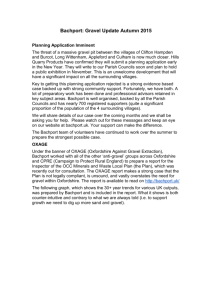TECHNICAL Gravel Roads Made Smoother, Less Dusty What Was the Need?
advertisement

2014-06TS Published March 2014 Gravel Roads Made Smoother, Less Dusty with Addition of Scrap Asphalt Shingles What Was the Need? TECHNICAL SUMMARY Technical Liaison: Tim Stahl, Jackson County Tim.Stahl@co.jackson.mn.us Project Coordinator: Dan Warzala, MnDOT Dan.Warzala@state.mn.us Principal Investigator: Tom Wood, MnDOT Thomas.Wood@state.mn.us LRRB PROJECT COST: $70,000 Minnesota generates more than 200,000 tons of waste roofing shingles annually. Most of this waste is landfilled, but recently small amounts of recycled asphalt shingles (RAS) have been successfully incorporated into hot-mix asphalt pavement mixtures. This has prompted MnDOT to investigate other possible uses for RAS, specifically postconsumer tear-off scrap shingles (TOSS). Incorporating RAS into aggregate for surfacing gravel roads has the potential for significant benefits beyond simply removing material from the waste stream. The grading and quality of surfacing gravel in the state have worsened over time as the best gravel sources have already been used. Areas that use limestone gravel also face significant dust control issues that RAS may help to alleviate. This project tested the performance of recycled asphalt shingles blended into aggregate for gravel roads. In one test section, the blend of shingles and gravel significantly reduced the amount of wash boarding on the road, while a blend of shingles and limestone on a second test section reduced dust production by 34 percent. The specific prompt for this project was a gravel road in Jackson County that has suffered severe wash boarding— closely spaced humps running perpendicular across the roadway surface. Wash boarding is thought to be caused by the displacement of aggregate fines by passing vehicles, especially when accelerating or stopping. Use of a chemical stabilization product and mixing clay into the gravel were unsuccessful at addressing the problem. The county had the idea that blending ground shingles, which contain high-quality fine aggregate, might alleviate the problem, but research was needed to test this solution. What Was Our Goal? This project aimed to determine whether RAS could be incorporated into the surface of a gravel road without negatively impacting performance, and whether doing so would mitigate wash boarding and dust. Wash boarding can be difficult to prevent on gravel roads and results in a rough ride. RESEARCH SERVICES & LIBRARY O FFI C E O F T R A NSP O R TAT I O N SYSTEM MANAGEMENT What Did We Do? Researchers first conducted laboratory testing to determine the physical characteristics of RAS and how it interacts with gravel. These tests included unit weight determination (in accordance with AASHTO test method T19), proctors to determine ideal moisture (modified AASHTO T99), indirect tensile strength (ASTM 6931) and triaxial shear (ASTM D2166-06). The moisture test was necessary to find the optimal moisture so samples could be compacted for the indirect tensile strength test, while indirect tensile strength and triaxial shear indicate how well the aggregate and ground shingles bind together. The tests identified the optimum ratio of shingles to aggregate. Researchers then built two test sections. In Jackson County, the road was constructed with a 1-1/2-inch layer of 40 percent (by volume) shingles, ground to pass through a 1/2-inch sieve, and 60 percent class 5 natural gravel. Researchers monitored this road, a down grade that had experienced significant wash boarding, for the performance of the surface. The second test section, in Goodhue County, was constructed with an even mix of TOSS and Class 6 limestone by volume. Researchers evaluated this section primarily for the effect of RAS on the road’s dust production. continued “The grading and quality of surfacing gravel have gotten worse over time because the best material and binders have already been harvested. In addition, areas that use limestone aggregate in their gravel roads can have serious problems with dust control.” —Tom Wood, MnDOT Research Project Supervisor In Goodhue County, which uses Class 6 limestone on its gravel roads, ground shingles were blended with aggregate in a half-mile section of County Road 6. The shingle blend reduced dust production by 34 percent after 298 days. What Did We Learn? “The shingles seem to work with aggregate the way fiberglass fibers work with concrete to increase tensile strength and bind the material together.” —Tim Stahl, Jackson County Engineer Lab testing found that binding strength peaked at a mix of 40 percent shingles by volume. According to Jackson County personnel, the blend of shingles and gravel significantly reduced the amount of wash boarding the road experienced. The section that used the shingle blend needed to be reshaped or bladed less often than control sections on the same roadway. County personnel also reported that the TOSS section recovered from the spring thaw faster than control sections, and it appeared to produce less dust. In Goodhue County, researchers observed the dust generated and compared the dust quantities collected with the Colorado Dust Collector. Observations indicated a reduction in dust from the TOSS section compared to control sections. This finding was confirmed by the Colorado Dust Collector test, which found that the TOSS section produced 34 percent less dust than the control section after 298 days. Previous work found that dust control treatments generally became ineffective within one year. Based on the promising experimental results, researchers drafted a special provision, for MnDOT consideration, for preparing waste shingles for use in gravel roadways. What’s Next? Researchers developed an implementation plan for this study, which includes conference presentations, a webinar, a video about the project, a two-page handout that outlines the findings and active outreach to other agencies. This research has already been presented at the TRB Annual Meeting and the International Conference on Atmospheric Dust. Jackson County also plans to continue monitoring the test section to learn how long the improved performance lasts. Produced by CTC & Associates for: Minnesota Department of Transportation Research Services & Library MS 330, First Floor 395 John Ireland Blvd. St. Paul, MN 55155-1899 651-366-3780 www.mndot.gov/research Issues related to waste shingle supply, including cost, storage and supply stability, are potential roadblocks to widespread implementation that Jackson County personnel are currently investigating. Ground RAS is approximately double the cost of gravel by weight, although comparable in cost by volume, and the rural areas that have the most gravel roads produce far fewer scrap shingles than urban areas. Possible solutions include working with solid waste facilities to keep shingles separate from the rest of the waste stream or reducing tipping fees for individuals who separate shingle waste. This Technical Summary pertains to the LRRB-produced Report 2014-06, “Research Using Waste Shingles for Stabilization or Dust Control for Gravel Roads and Shoulders,” published January 2014. The full report can be accessed at http://www.lrrb.org/PDF/201406.pdf.





